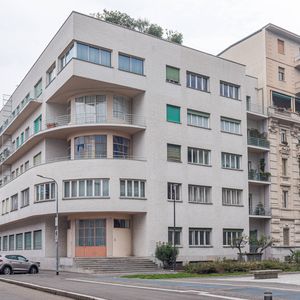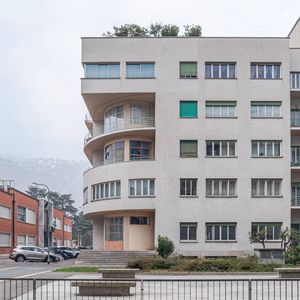Giuseppe Terragni, Novocomum, viale Sinigaglia 1, 1927-29
The Novocomum Society’s apartment house is the first building constructed by Terragni. The assignment involved the completion of an eclectic building designed a few years earlier by the architect Caranchini, with the aim of creating a unified courtyard layout. Terragni presented a project to the Building Commission that stylistically rediscovers the pre-existing architecture. Under the scaffolding, on the other hand, what was just completed was called the 'Transatlantico” (Transatlantic), due to its uncommon nautical shape. The scandal was such that a Commission was appointed to decide whether to demolish the building or leave it as it was, the controversy reached the pages of the most important architecture magazines, Giuseppe Pagano on "La casa bella" and Giò Ponti on "Domus" defend this architecture as one of the first rational examples. The layout of the building is the most common one used to obtain a large volume and is typical of intensive construction. There is only one entrance, from Viale Sinigaglia and on the axis of the façade, with an internal staircase leading immediately to the mezzanine floor and the atrium, and with the porter's lodge at the side. Terragni works by juxtaposing and subtracting volumes, overlapping and interlocking. The overall system is relatively simple. In fact, the building is the result of the combination of five parallelepipeds: two parallelepipeds are added to the main body, which arranged parallel to the lake, and two smaller bodies are added in the courtyard. The corners of the body facing the lake are hollowed out, subtracting two portions of volume but leaving the top floor intact, so that it restores the outline of the building. The two glass cylinders of ovoid cross section are wedged inside these cavities: they are locked at the top from the top floor and locked at the bottom by the enveloping body of the first floor and the balcony of the second floor. The compositional logic of the Novocomum is not in itself anomalous: it takes up on usual patterns which it accentuates and exasperates. The overlapping and interlocking techniques are also relatively normal, but accentuated with differences in material and colour. Terragni used colour in his original project, denying the deep-rooted idea of rational architecture in black and white.
Today the building, apart from the façade now covered in marble tesserae, has been restored to its original colours by a recent restoration

